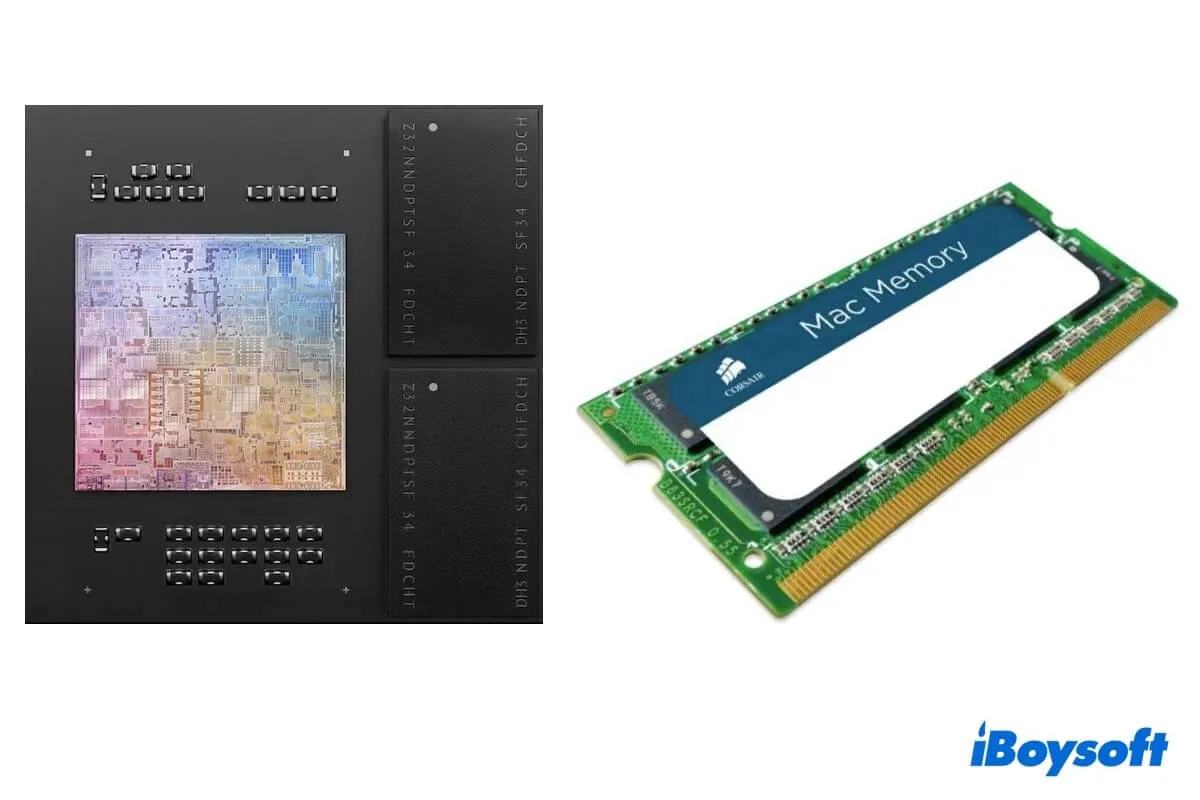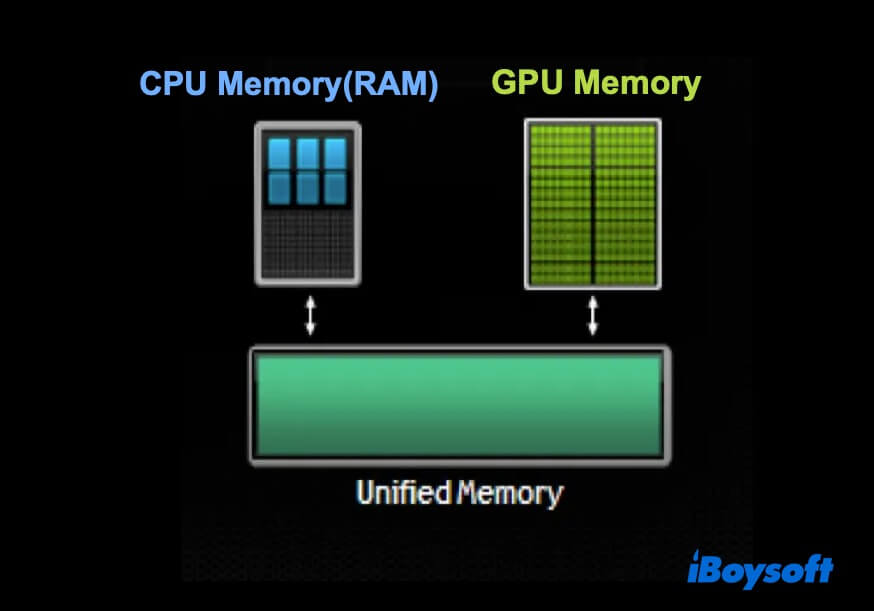Literally, Unified Memory and RAM (Random Access Memory) are called memory, on a deeper level, they refer to different storage technologies.
Briefly, unified memory allows different components to process tasks simultaneously when they need the same data. RAM provides the system and programs instant access to the data in current use.
If you want to explore more secrets about unified memory vs. RAM, follow this article. It will introduce unified memory and RAM respectively, compare the two, and answer your questions about them, such as "Is unified memory the same as RAM?", "How much unified memory or RAM do I need?", etc.
| Unified Memory | RAM | |
| Main use | Memory pool shared by the CPU and GUP components | Main memory in a computer for storing data currently being used by the system and programs |
| Effects | Improve computer performance and efficiency | Improve computer performance and efficiency |
| Volatility | Non-volatile | Volatile |
| Capacity | 8GB, 16GB, 32GB, 64GB, 128GB | 4GB, 8GB, 16GB, 32GB |
| Influence on computer speed | Greatly boosts computer speed | When RAM is enough, boosts computer speed. Conversely, lags |

What is unified memory?
Unified memory is a pool of storage shared by all the processing components of the computer. It allows multiple processing components to access the same resources in the memory pool simultaneously without conflicts. That enables processing units can go hand in hand to execute different tasks, which greatly improves performance and efficiency on computers.
For Apple, unified memory denotes a memory architecture (Unified Memory Architecture or UMA) that they have implemented in their Apple silicon chips. It is also often called high-bandwidth and low-latency memory.
Apple's Unified Memory Architecture makes the CPU (Central Processing Unit) and GPU (Graphics Processing Unit) share a single address space. Traditionally, the CPU and GPU usually have discrete memory spaces - RAM and vRAM, requiring explicit data transfers between them.

What is RAM?
RAM (Random Access Memory) is also called short-term memory or temporary memory. It is the main memory in a computer that is used to store data currently being used by the system and applications for quick retrieving.
With the assistance of RAM, your computer can perform tasks quickly, such as launching a function within an application, switching across multiple programs, browsing web pages from browsing history, etc.
So, the larger RAM your computer has, the quicker performance it will have. However, RAM is hardware in your computer device and is fixed in capacity. Usually, a modern computer has 4GB, 8GB, 16GB, or 32GB of RAM.
RAM is volatile. It can only store data generated by the system and programs when the computer is on. When the device is off, the data stored in RAM goes away as well.
Unified memory vs. RAM: Differences & Similarities
Although both unified memory and RAM can improve the performance of the computer, the two have significant differences. This part will discuss these aspects of Mac unified memory vs. RAM:
- Primary use
- Volatility
- Influence on computer peed
- Capacity
Unified memory vs. RAM in primary use
Unified memory stores data for both GPU and CPU needs while RAM only holds data for the CPU.
Unified memory combines the traditional RAM and vRAM which separately for CPU and GPU into one memory address. Hence, processing components won't need to switch from different locations to look for resources and proceed with respective tasks in order.
Unified memory makes the CPU and GPU able to interpret, process, and execute instructions quickly and smoothly. Then, you'll get a better and quicker experience in gaming, image processing, video clips, or other complicated graphics-involved tasks on your computer.
RAM is a system memory that is mainly used by the CPU to store its temporary data for carrying out some tasks like quickly opening an app that has been launched.
Unified memory vs. RAM in volatility
Unified memory is non-volatile and can hold the data in its memory pool whether there's a power supply or not. In other words, even when a power outage happens, data in unified memory is maintained and won't be lost.
RAM is volatile as it's a typical temporary memory. When a computer boots up and programs run, data produced by the running system and software are stored in RAM. When the device is turned off, this data is automatically cleared up from RAM.
Unified memory vs. RAM in capacity
Unified memory is a design on an Apple silicon chip to enable the CPU and GPU to share the same memory location for data storage. The RAM shown on your Mac equals the unified memory. You can check on your Mac in the Apple menu > About This Mac > Overview. Here, memory refers to RAM, which ranges from 8GB to 128 GB.

RAM is a hardware memory in a computer and has a fixed size, usually 4GB to 32 GB. It is built into your computer. If you need more RAM, you need to purchase suitable memory and add it to your computer or send your machine to a local shop to add more.
Unified memory vs. RAM in influence on computer speed
Unified memory is more of a data storage technique. It allows CPU and GPU components to quickly and simultaneously access data in a single memory pool. It works to improve the performance of your computer. So, we can say that unified memory improves the computer speed.
For RAM, it has a limited storage capacity. The more programs you run on your device at the same time, the more RAM will be consumed. When RAM is almost run out, your Mac will run slowly.
As RAM is mainly used by the CPU, you can check in Activity Monitor on a Mac to see how much RAM you use and close useless programs to release RAM.
How much unified memory and RAM do you need?
Unified memory is a new design of Apple to combine the RAM and visual RAM (vRAM) into one memory pool on their M-series chips. There's no accurate capacity definition of it. But RAM is clearly labeled on your Mac (About This Mac).
However, Apple claims that 8GB of unified memory on an Apple silicon Mac equals to 16GB of RAM (or memory) of a regular Mac.
The capacity of the unified memory and RAM you need depends on what tasks you usually proceed with on your Mac. If you use your Mac for daily document writing, simple image processing, and video clips, 8GB is enough.
If you use your Mac mainly for program editions, animation creation, gaming, or other memory-intensive tasks, 16GB or 32GB of RAM or an Apple Silicon Mac with unified memory is better.
FAQs about unified memory vs RAM
- QIs unified memory the same as RAM?
-
A
No, unified memory works to integrate RAM and vRAM into one memory location for CPU and GPU components to store and access data. RAM is the computer memory that used to store temporary data created by system and running apps.
- QIs Unified RAM better than RAM?
-
A
Yes, unified memory greatly boost your Mac performance. Unified memory stores data both GPU and CPU needs for quick access and task processing while RAM only holds data for CPU.